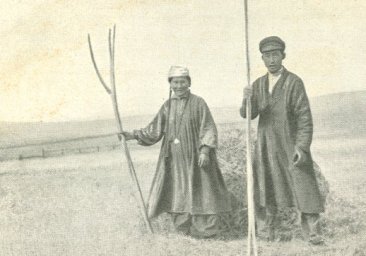It's the stuff of legend: A Buryat community down under. Recently, a colleague/buddy (hey, in the world of Buryatology, we're all buds) shot a question out about the Australian Buryats. I shrugged, not knowing anything about Australia or any potential long-lost Aga Buryats there. A recent visitor of Aga Buryat extraction thought the Australian hypothesis somewhat improbable, as no one from there had ever come back to Aga to say hi. Very reasonable.
But then, as I sat recently at our local library, reading and wishing I had a cookie, I came across this tidbit in a 2005 book by B. Shirnen published in Ulaanbaatar and titled Buriadyn nuudel--khel, aialguuny uchir. There, to my great surprise, I discovered not just a passing mention, but a whole subsection on the Buryats of Australia (pp 81-83).
The story is pretty wacky. The story begins in 1981, when a Buryat archery champ from the Chita region met an old man who spoke Buryat and told the tale of Australia's 40-odd Buryat households whose ancestors had left Aga during difficult times. First, Buryats were drafted into the Russian military to dig ditches and built fortifications in World War I. Prior to this draft, "native peoples" such as the Buryats had been exempt from military service (with the exception, naturally, of the Buryat Cossacks). Then, the Civil War broke out a few years later, and many intellectual and religious leaders decided it would be better to move to Inner or Outer Mongolia.
However, several enterprising young Buryats decided to look for the legendary homeland of Nayan Navaa and headed for Japan. They traveled long through Manchuria, asking the way, until they reached the Pacific. After they were robbed at port, they were taken by a ship's captain to Australia, to become servants of a wealthy man there who understood only two words of his new employees' language: "Chinggis" and "Mongol".
The Buryats herded their new master's sheep and took care of his flocks on Australia's grasslands. Their master treated them like slaves, but eventually they learned to read and write English, and through mutual support were able to get their own farms and start families.
Read more in an oh so accessible article by a certain Galsan, "Avstrali ruu achigdsan buriad," an article in the Tsagaan-Ovoo sum (Dornod Aimag, Mongolia) newspaper from 1995 (no. 8). Hey, no one ever said Buryatology was easy.

Wednesday, May 14, 2008
Subscribe to:
Post Comments (Atom)
1 comment:
http://buryadnom.blogspt.com
Post a Comment